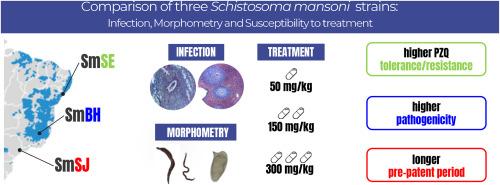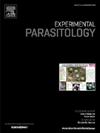3株曼氏血吸虫感染、形态测定及对治疗的敏感性比较。
IF 1.6
4区 医学
Q3 PARASITOLOGY
引用次数: 0
摘要
不同的曼氏血吸虫株表现出不同的表型,影响寄生虫的分布、控制策略和血吸虫病的治疗方案。本研究比较了3种巴西菌株:Belo Horizonte/MG (SmBH)、Ilha das Flores/SE (SmSE)和s本文章由计算机程序翻译,如有差异,请以英文原文为准。

Comparison of three Schistosoma mansoni strains: Infection, morphometry and susceptibility to treatment
Different Schistosoma mansoni strains exhibit distinct phenotypes, influencing parasite distribution, control strategies, and therapeutic alternatives for schistosomiasis. This study compared three Brazilian strains: Belo Horizonte/MG (SmBH), Ilha das Flores/SE (SmSE), and São José dos Campos/SP (SmSJ). To understand differences in infection, morphometry and response to praziquantel (PZQ) treatment, BALB/c mice were infected with each strain and treated 45 days post-infection (dpi) with praziquantel (PZQ) in different dosages. Egg elimination was monitored weekly from 30 dpi and euthanasia was performed 60 dpi. Untreated groups showed SmBH with the highest infection rates, with a larger number of recovered worms and a greater number of eggs. Morphometric analysis showed that SmSE females were significantly longer, while SmBH eggs were larger. Granuloma size was similar in SmBH- and SmSJ-infected mice, but SmSE-induced granulomas were smaller. SmBH infection resulted in a greater number of granulomas, suggesting higher pathogenicity. PZQ treatment at 150 or 300 mg/kg significantly reduced parasite burden, fecal egg count, and hepatic/intestinal granulomas in SmBH- and SmSJ-infected mice. SmBH infection also showed fewer immature and mature eggs and more dead eggs after treatment. However, SmSE-infected mice exhibited no significant differences between treated and untreated groups, suggesting higher resistance/tolerance to PZQ. These findings highlight phenotypic differences among S. mansoni strains: SmBH produced and retained more eggs, aggravating pathology; SmSJ had the lowest egg production; SmSE showed the highest resistance to PZQ. Understanding strain variability is crucial for improving schistosomiasis control and advancing drug development.
求助全文
通过发布文献求助,成功后即可免费获取论文全文。
去求助
来源期刊

Experimental parasitology
医学-寄生虫学
CiteScore
3.10
自引率
4.80%
发文量
160
审稿时长
3 months
期刊介绍:
Experimental Parasitology emphasizes modern approaches to parasitology, including molecular biology and immunology. The journal features original research papers on the physiological, metabolic, immunologic, biochemical, nutritional, and chemotherapeutic aspects of parasites and host-parasite relationships.
 求助内容:
求助内容: 应助结果提醒方式:
应助结果提醒方式:


